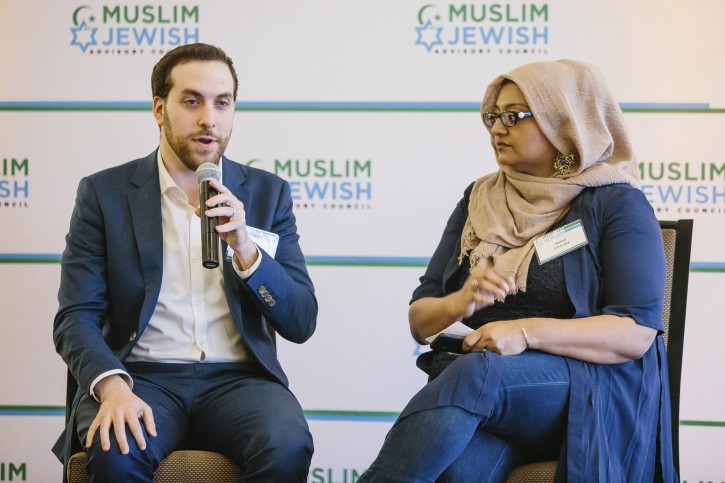
New York – For many Jewish journalists in the U.S., persistent online anti-Semitic harassment has become part of the job.
The phenomenon became pervasive during the 2016 presidential campaign, and there’s been a resurgence in recent months ahead of next week’s midterm election, according to the Anti-Defamation League.
Targeted journalists have found different ways of responding. CNN commentator Sally Kohn reaches out kindly to some of her online harassers. Michael Duke, an editor at the Houston-based Jewish Herald-Voice, has reduced his use of social media. Yair Rosenberg, a writer with Tablet Magazine, developed a method of tracking down and disrupting anti-Semitic accounts on Twitter.
Rosenberg has written in detail about the vitriol directed at him, including a doctored photo showing him a gas chamber. When the ADL reported that he received the second-most abuse of any Jewish journalist on Twitter during the 2016 campaign, Rosenberg wrote, “My parents didn’t raise me to be No. 2; fortunately, there’s always 2020.”
Twitter, over the past two years, has become more effective at removing certain types of virulent anti-Semitism from its feeds, according to Rosenberg. But he said the company is less effective at blocking the spread of anti-Jewish conspiracy theories in tweets that avoid certain phrases and hashtags that would catch the eye of Twitter monitors.
Rosenberg said he has grown hardened to the constant flow of anti-Semitic material.
“I don’t feel like a victim,” he said by telephone from Pittsburgh, where and he and his Tablet colleagues are covering the aftermath of the synagogue shooting Saturday that killed 11 Jews.
“What some people deal with in real life is worse than what I deal with online,” he said. “There’s life-and-death stuff, and there’s me getting mean tweets.”
A few spots below Rosenberg on the ADL’s 2016 “Top 10” list was Kohn, a liberal political commentator who appears regularly on CNN.
For a book she published earlier this year, “The Opposite of Hate,” she reached out to several of her own Twitter trolls, conversing with them about the reasons for their vitriol and in some cases receiving apologies.
In an interview Tuesday, Kohn said she is now less tempted to engage with her harassers.
“It’s all just so negative,” she said. “I’ve stopped paying as much attention to my trolls.”
Also on the 2016 Top 10 list was Jonah Goldberg, a senior editor of the conservative National Review. He began receiving a torrent of online anti-Semitic invective in the second half of 2015, after Donald Trump declared his presidential candidacy and Goldberg was among the conservative commentators who expressed misgivings.
“You had endless photoshopped images — Trump in an SS outfit putting me in a gas chamber,” he said. “You don’t see that stuff very much anymore.”
However, he said there was a new surge of anti-Semitic material — much of it generated by bots — after the Pittsburgh massacre.
“They flood the zone in the wake of these kind of controversies … sowing discord and distrust,” he said.
Like Rosenberg and Kohn, Goldberg tries to take the harassment in stride, though he took notice when photos of his dog became vehicles for further anti-Semitic abuse.
One specific episode still stands out: Goldberg said that at one point he made public reference to the death of his brother, and was “pelted with jokes asking if he’d been turned into soap or a lampshade.”
“I have a pretty thick skin,” he said. “The sheer inhumanity of it — that’s stuck with me.”
At The Forward, a New York-based Jewish magazine, editor-in-chief Jane Eisner said anti-Semitic harassment directed at her staff surged in 2016, prompting new procedures for reporting particularly menacing threats to the police.
“There’s no doubt we’ve gotten used to this, which in some ways is a tragedy, but we have to do our job,” Eisner said. “Just because you accept it and move on doesn’t mean it doesn’t affect you.”
At the ADL, one of the experts tracking anti-Semitic harassment is Daniel Kelley, associate director of the ADL’s Center for Technology and Society. Even if some prominent Jewish journalists are able persevere in the face of such harassment, he worries that some Jews might be deterred from pursing a journalism career for fear of becoming a target.
In Houston, Duke, a Jewish Herald-Voice associate editor, was targeted with anti-Semitic abuse after the paper reported on a 2016 visit by white nationalist leader Richard Spencer to Texas A&M University. Duke was called a “Zionist Nazi” and was emailed a photo of Auschwitz with the tag, “We’re on the march.”
But there’s been an upside to Duke’s subsequent decision to reduce his engagement on social media.
“It’s made me a little better as a journalist,” he said. “With social media, you can be a little lazy. This puts me back in touch in touch with people we write about.”
As reported by Vos Iz Neias
